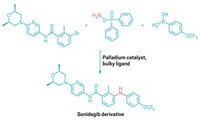Advertisement
Grab your lab coat. Let's get started
Welcome!
Welcome!
Create an account below to get 6 C&EN articles per month, receive newsletters and more - all free.
It seems this is your first time logging in online. Please enter the following information to continue.
As an ACS member you automatically get access to this site. All we need is few more details to create your reading experience.
Not you? Sign in with a different account.
Not you? Sign in with a different account.
ERROR 1
ERROR 1
ERROR 2
ERROR 2
ERROR 2
ERROR 2
ERROR 2
Password and Confirm password must match.
If you have an ACS member number, please enter it here so we can link this account to your membership. (optional)
ERROR 2
ACS values your privacy. By submitting your information, you are gaining access to C&EN and subscribing to our weekly newsletter. We use the information you provide to make your reading experience better, and we will never sell your data to third party members.
Business
Scifinder’s New Tool
Sciplanner lets chemists visually interact with Chemical Abstracts Service data
by Carmen Drahl
April 18, 2011
| A version of this story appeared in
Volume 89, Issue 16

Bryan Branstetter’s line of work requires a lot of searching. A medicinal chemist at Dart NeuroScience, a small but growing biotechnology company in San Diego, he’s constantly on the lookout for patents, reactions, and chemical suppliers that’ll help him build molecules to treat cognitive decline. Starting this week, Branstetter and thousands of other chemists like him have one more computer search option to help them: SciPlanner, a new addition to Chemical Abstracts Service’s (CAS) SciFinder research tool. CAS, in Columbus, Ohio, is a division of the American Chemical Society, which publishes C&EN.
A traditional SciFinder search brings up search results in list form. Although these results can be refined, analyzed, or saved for related searches later, making connections between searches isn’t always intuitive and may be a time-consuming process. CAS’s new SciPlanner tool, which launches on April 18, is a white-board-like digital space where chemists can organize multiple searches into the form of synthetic routes. The tool is designed to help chemists plan and prioritize their own routes.
SciPlanner places the reaction, structure, patent, literature, and supplier information from SciFinder into an interactive space. The tool connects the common points in various reactions, creating a network of syntheses that can be studied in-depth. “It lets you build a virtual reaction scheme first, and then lets you pull in all the information you need about the components,” explains Branstetter, who was a tester for the interface.
“It’s like a blank canvas where you can interact with your data,” adds Jeffrey M. Wilson, a Ph.D. chemist and manager of SciFinder Product Development.
Computer programs for synthetic planning are not new, from pioneering efforts such as the Organic Chemistry Synthesis Simulator from Harvard’s E. J. Corey in 1969 all the way to today’s commercial synthesis planners such as that contained in Elsevier Properties’ Reaxys. But SciPlanner is the first to draw information from CAS databases including the CAS Registry, with its more than 57 million compounds, and CASREACT, which contains reactions from 1840 to the present.
SciPlanner also lets chemists move directly from synthetic schemes to the experimental procedures underlying each step, which are culled from patents and from ACS journals such as Organic Letters. This is a huge time-saver, Branstetter says, because chemists often must comb lengthy papers and patents to find one small paragraph relevant to a synthesis.
Currently, the SciPlanner interface can map out a network of synthetic routes containing up to 200 components, and up to 20 such plans can be saved, Wilson says. This is a useful feature because a chemist might explore a route and then not come back to it for a few months, Branstetter says. “It helps you stay a little more organized.”
Electronic tools like SciPlanner are a useful complement to electronic lab notebooks, which have become common in the pharmaceutical industry, Branstetter adds. By putting synthesis plans in a savable, searchable spot, and connecting to patent and literature information, “they put all your resources at your fingertips,” he says. “In a nutshell, it just makes your job easier.”



Join the conversation
Contact the reporter
Submit a Letter to the Editor for publication
Engage with us on Twitter